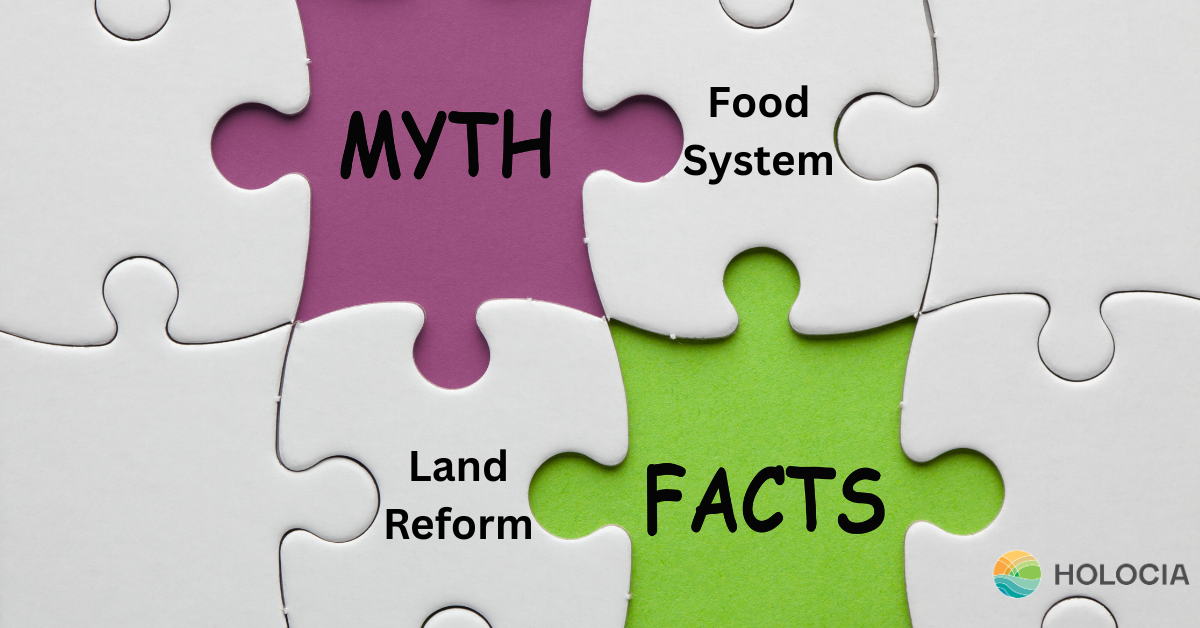Myths about our food system and land reforms
Nature Farms • Aug 13, 2025 11:24:42 AM • Written by: Patrick Van Haren

Based on some selected sources, we compiled a list of different myths discussed regarding the food system and land reform.
- Myths and Facts of our Food System and Land Reform with thoughts compiled from Barons: Money, Power, and the Corruption of America's Food Industry by Austin Frerick;
- Land Power: Who has it, who doesn't, and how that determines the fate of societies by Michael Albertus; and
- The Problem with Feeding Cities: The Social Transformation of Infrastructure, Abundance, and Inequality in America by Andrew Deener
Subscribe to our newsletter if you want to learn more and read the blog posts addressing these myths.
-
- Myth: Consumers have a wide array of choices at the grocery store. This is an "illusion of choice," as many brands are owned by a few large corporations through "roll-up" strategies, meaning perceived competition is often just different labels from the same dominant entities.
- Myth: Buying from the biggest companies ensures the best value and quality due to their efficiency and scale. Large retailers like Walmart use groceries as a "loss leader" and leverage immense buyer power, while large distributors like Sysco, despite convenience, lead to a decline in food taste and quality by prioritizing efficiency over local sourcing.
- Myth: Academic research and expert opinions on agriculture are objective and trustworthy. Agricultural economics is characterized as a "corrupt academic discipline" where researchers frequently receive undisclosed corporate funding from "Big Ag," leading to financially influenced studies that can mislead public discourse.
- Myth: Industrial-scale farming is the only economically viable and efficient way to produce food today. This approach, often supported by Wall Street and government programs, "designs family farms to fail" through overproduction, making them "very fragile," and contributing to severe environmental degradation despite increased output.
- Myth: Simply adding more food retail (like supermarkets) will solve food access issues. This overlooks deeper structural and historical forces, such as infrastructural disruptions tied to market formation and urbanization, that created "food deserts" in the first place.
- Myth: The food system's issues are natural evolutions or malicious designs by a few bad actors. This leads to efforts focused on blaming individual corporations rather than understanding the complex sociological and historical evolution of the system driven by capitalism and efficiency.
- Myth: Focusing on profit margins can coexist with widespread human well-being in the current food system. The system's underlying logic shifted from fulfilling basic needs to satisfying profit margins, which inherently creates pervasive social and spatial inequalities.
- Myth: Specific problems within the food system are isolated and can be addressed independently. Issues like the struggles of the restaurant industry, dangers for food workers, or food waste are interconnected symptoms of a deeply problematic infrastructure, and attempts to fix one in isolation will fall short.
- Myth: Land reform universally ensures complete property rights and equitable outcomes. Historically, many land reform programs, especially by authoritarian governments, deliberately withhold complete property rights from beneficiaries to create "coercive leverage" and secure power, often leading to increased inequality or economic instability.
- Myth: Land reforms are always progressive and driven by equity. Autocratic land reforms are often designed to "secure [the ruler's] power" and "prevent democratic change," sometimes allocating more land to the elite or increasing inequality among tillers as a "divide and rule" strategy.
.png?width=400&height=200&name=Holocia%20hz%20(400%20x%20200%20px).png)
